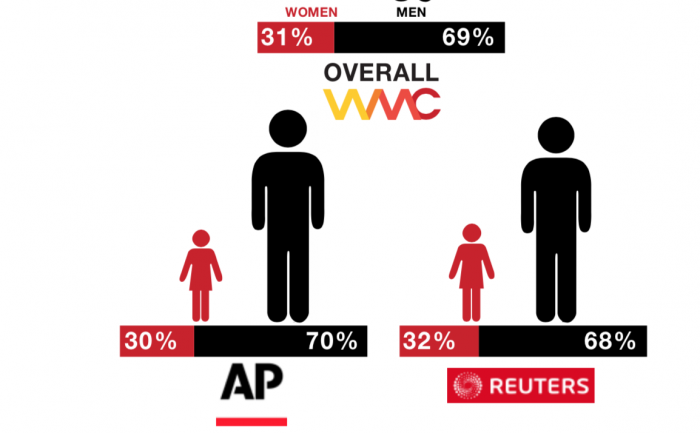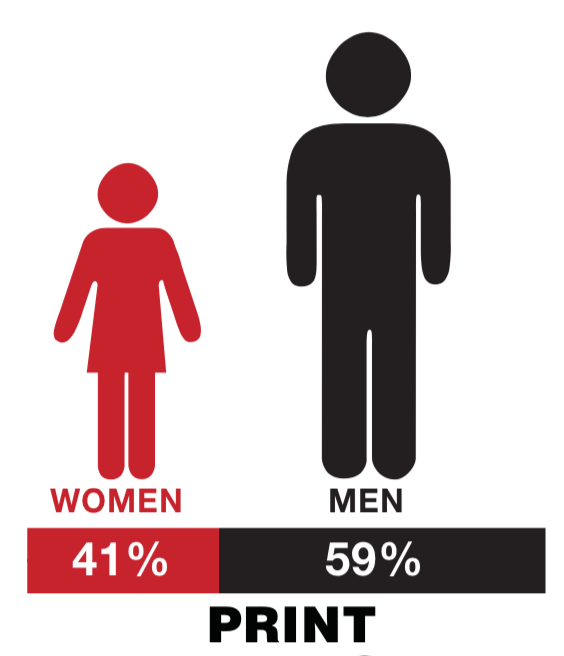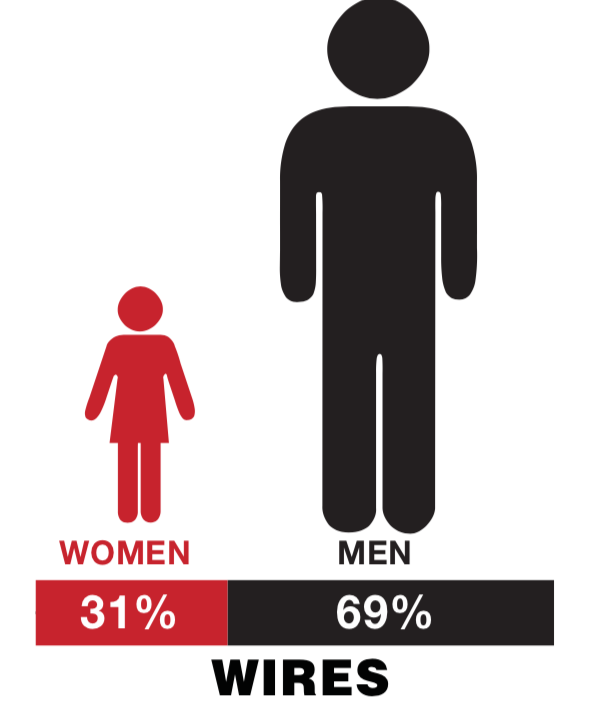
The dismal factoids in a new report released Thursday by the Women’s Media Center go on and on. And on.
While women outnumber men in journalism programs and in colleges, they represent just 41.7 percent of newsroom employees, according to the 2018 diversity survey by the American Society of News Editors. That survey also received a record low number of responses — just 17 percent of the 1,700 organizations surveyed responded.
Men continue to report and produce the majority of U.S. news, and the gap is particularly egregious at the news wires: 69 percent of AP and Reuters bylines go to men, “by far the biggest gender gap in news media.”
And men continue to dominate both “hard news” topics (international, politics, crime) and, uh, nearly every other topic as well (weather! social and justice issues! entertainment! religion! business!).
“The media is in a state of great disruption, but despite all the change, one thing remains the same: fewer women report the news than men,” said Julie Burton, WMC president.
The 100-plus-page report looks at many forms of media, including film, TV, online streaming, and theater. For the purposes of this post, though, I’ll just focus on the journalism findings, which WMC collected between September 1 and November 30, 2017 (so, yes, they are from more than a year ago).
 WMC reviewed content from 14 print newspapers (Arizona Republic, Chicago Sun-Times, Chicago Tribune, Houston Chronicle, Los Angeles Times, Newsday, New York Post, Dallas Morning News, New York Times, Philadelphia Inquirer, San Jose Mercury News, Wall Street Journal, Washington Post, and USA Today). The byline analysis was limited to articles “collected from the first, or A section.”
WMC reviewed content from 14 print newspapers (Arizona Republic, Chicago Sun-Times, Chicago Tribune, Houston Chronicle, Los Angeles Times, Newsday, New York Post, Dallas Morning News, New York Times, Philadelphia Inquirer, San Jose Mercury News, Wall Street Journal, Washington Post, and USA Today). The byline analysis was limited to articles “collected from the first, or A section.”
The widest gender gap was at USA Today, where 69 percent of A-section articles were written by men, 31 percent by women. The narrowest was at The Philadelphia Inquirer, where 52 percent of A-section articles were written by men and 48 percent by women. Overall, women wrote 41 percent of A-section articles and men 59 percent (a slight improvement from WMC’s study the year before, when women wrote 38 percent of A-section articles).
(It’s worth noting here that The New York Times released its own diversity report for the first time last March. It said that in 2017, 62 percent of its new hires in news and opinion were women; it didn’t look at bylines. Most newsrooms don’t release such data on their own.)
 WMC looked at Reuters and AP, focusing on articles over 500 words. Its analysis included every article with an identifiable byline.
WMC looked at Reuters and AP, focusing on articles over 500 words. Its analysis included every article with an identifiable byline.
At both Reuters and AP, women fared worse than they had in WMC’s previous study. At the AP, men nabbed 70 percent of bylines — up from 65 percent in the earlier study. At Reuters, men got 68 percent of bylines, up from 61 percent.
WMC looked at eight of the largest online news sites — the websites of HuffPost, The New York Times, The Washington Post, Fox News, CNN, the Los Angeles Times, Vox, and MSNBC.

HuffPost, Vox, and MSNBC did well: Women got 50 percent of bylines at HuffPost, 51 percent at Vox, and 51 percent at MSNBC. (WMC didn’t include BuzzFeed in its survey, for whatever reason — but BuzzFeed said in 2018 that more than half of its global staff identifies as female.)
NYTimes.com did the worst, at least for the online articles WMC looked at: Men got 67 percent of online bylines, women 33 percent. WMC also notes that at “The Washington Post, The New York Times, and [the] Los Angeles Times, the gender gaps were wider in their online editions than their print editions.”
No surprise that there are also major disparities in the topics assigned to men versus women (although, okay, I was still surprised by some of them. Like, why do men get weather?) At the 14 print newspapers:
— Women fared worst on sports desks, with 90 percent of those printed sports articles written by men; 10 percent were written by women.
— In male-dominated technology and media coverage, men got credits on 67 percent of articles and women, 33 percent.
— In male-dominated international news and political coverage, men got 66 percent of byline credits; women got 34 percent.
— In female-dominated health coverage, women accounted for 58 percent of bylines. For lifestyle/leisure coverage, women took 52 percent of bylines. These were the only two categories dominated by women.
At the news wires:
— 93 percent of technology and media coverage credits went to men and 7 percent of them to women.
— 86 percent of sports coverage credits went to men, 14 percent to women.
— 80 percent of legal coverage credits went to men, 20 percent to women.
— 73 percent crime and police coverage credits went to men, 27 percent to women.
— 71 percent of arts and culture coverage credits went to men, 29 percent to women.
— 70 percent of international news and politics coverage credits went to men, 30 percent to women.
— 66 percent of weather news coverage credits when to men, 34 percent to women.
— 63 percent of U.S. elections coverage credits went to men, 37 percent to women.
— 63 percent of social and justice coverage credits went to men, 37 percent to women.
— 61 percent of health coverage credits went to men, 39 percent to women.
— 60 percent of science and environment coverage credits went to men, 40 percent to women.
— 60 percent of religion coverage credits went to men, 40 percent to women.
— 59 percent of U.S. policy coverage credits went to men, 41 percent to women.
— 57 percent of business and economy news coverage credits went to men, 43 percent to women.
— 50 percent of lifestyle and leisure news coverage credits went to men, 50 percent to women.
— 42 percent of education news coverage credits when to men, 58 percent to women.
— 35 percent of entertainment news coverage credits when to men, 65 percent to women.
And at online news sites:
— 79 percent of sports news coverage credits went to men and 21 percent of them to women.
— 74 percent of U.S. elections news coverage credits went to men, 26 percent to women.
— 65 percent of legal news coverage credits went to men, 35 percent to women.
— 61 percent of weather news coverage credits went to men, 39 percent to women.
— 60 percent of U.S. policy news coverage credits went to men, 40 percent to women.
— 60 percent of science and environment news coverage credits went to men, 40 percent to women.
— 59 percent of crime and police news coverage went to men, 41 percent to women.
— 59 percent of international news and politics news coverage credits went to men, 41 percent to women.
— 57 percent of technology and media news coverage credits went to men, 43 percent to women.
— 57 percent of business and economy news coverage credits went to men, 43 percent to women.
— 55 percent of religion news coverage credits went to men, 45 percent to women.
— 53 percent of social and justice news coverage credits went to men, 47 percent to women.
— 53 percent of entertainment news coverage credits went to men, 47 percent to women.
— 52 percent of arts and culture news coverage credits went to men, 48 percent to women.
— 52 percent of education news coverage credits went to me, 48 percent to women.
— 53 percent of lifestyle and leisure news coverage credits went to men, 57 percent to women.
— 41 percent of health news coverage credits went to men, 59 percent to women.
The report also includes findings aggregated from other surveys, such as ASNE’s and Columbia Journalism Review’s “Who’s the Boss.” It is all infuriating. The full report is here.